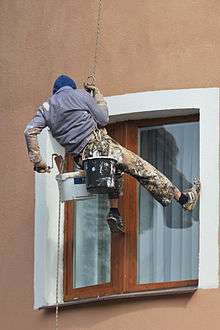Rope access



Rope access is a form of work positioning, initially developed from techniques used in climbing and caving, which applies practical ropework to allow workers to access difficult-to-reach locations without the use of scaffolding, cradles or an aerial work platform. Rope access technicians descend, ascend, and traverse ropes for access and work while suspended by their harness. Sometimes a work seat may be used. The support of the rope is intended to eliminate the likelihood of a fall altogether, but a back-up fall arrest system is used in case of the unlikely failure of the primary means of support. This redundancy system is usually achieved by using two ropes - a working line and a safety line.[1]
The most common applications for modern rope access include inspection, surveying, maintenance, and construction on bridges, dams, wind turbines, towers, buildings, and industrial plants. While inspection is the most common application, painting, welding, cutting and heavy material handling can be accomplished by rope access professionals using specialised procedures. The industry adheres to safety characteristics including:
- When working a rope access the technician always has at least 2 attachments, each having an independent anchorage point.
- When the worker is supported by ropes, each of the worker's ropes will have a fail-safe descent mechanism.
- All secondary tools and equipment (e.g. drills, sealant) are attached by lanyards to the worker's harness to avoid danger to people below.
- A minimum of two trained technicians are required for any job, each with the ability to rescue the other if needed.
- All technicians are independently assessed.
- All equipment is regularly inspected and maintained.
- Carefully refined codes of practice and working systems are used.
Trade associations such as IRATA and SPRAT have mandatory policies where member companies must submit all accident, incident and near miss occurrences to permit evaluation and comparison of information from an entire industry. This highlights any trends in incidents and assists in the evolution of equipment and procedures allowing continuing improvement to work practices. The above techniques along with the trade association’s organic approach has meant very few accidents since the beginning of this activity around the 1980s.[2]
Applications
Typical applications include:
- Inspection, painting and construction on offshore oil platforms and power plants.
- Inspection, surveying, maintenance on wind turbines.
- Inspection, surveying, maintenance, and construction on bridges and dams.
- Window cleaning, repair and aircraft warning light maintenance on high-rise buildings.
- Maintenance on aerials, telecommunication and electrical transmission towers (pylons).
- Construction assist on stadiums, spires, and other unique shape structures.
- Inspection, documentation and access to large building façades.
- Events rigging and installations such as banners, flags, lighting and fireworks.
Equipment
Typical equipment includes:
Climbing helmet, a piece of safety equipment that primarily protects the skull against falling debris. As rope access is an industrial application, helmets are mandatory as they would be on a construction site. A head injury causing the victim to become unconscious introduces the risk of orthostatic hypotension through the restriction of blood flow caused by the victim’s own unsupported weight in the harness.
Sit harness, consisting of a waist belt and two leg loops which are normally connected in the front of the hips through a permanent webbing loop.
Chest harness, worn around the shoulders, usually with a sit harness so as to provide an additional attachment point farther up the body. This attachment point allows for better balance in some situations, such as when carrying a heavy pack (as the centre of mass is below the connection to the rope) and when the person in the harness may be unable to maintain an upright position (due to injury or other influences).
Full-body harness, the combination of a sit harness and a chest harness which are permanently or semi-permanently connected to each other. This kind of harness normally offers a wide range of attachment points. It is most commonly used in industrial/rescue situations.
Ascender, a mechanical device used for ascending on a rope. Ascenders offer similar functionality to friction knots, but are faster, safer and easier to use.
Safety back-up device, this is the most important tool as it a provides a redundancy should an ascender, descender, working rope or anchor fail. It is attached to the safety (second rope) and designed to be kept as high as possible to reduce the distance fallen in the event of a fall. The safety devices usually relies on friction transferred to the safety rope by means of a cam. The Petzl Shunt, a recreational climbing device, has been used successfully for many years for the safety back-up because it is positionable by the user, allowing it to be high above them at the work site and thus providing optimum protection. Concern over potential misuse and lack of user instructions or support for its use by Petzl has led to the development of other devices, including the Petzl ASAP, the DMM Buddy Catch and the SafeTec Duck-R. Unlike traditional devices that rely on friction to absorb shock the ASAP relies on a toothed wheel and an rip-stitch single use shock pack and although has the advantage of self trailing it tends to creep below the user. The Duck-R is a beefed-up stainless steel Shunt-shaped device designed specifically for use in rope access. All devices are connected back to the harness by means of a lanyard, otherwise known as a cow's tail, and fastened to the lanyard by a screwgate carabiner.
References
- ↑ Industrial Rope Access, Best Practices & Industry Standards, Jan Holan
- ↑ Health and Safety, IRATA.
External links
- IRATA International - Industrial Rope Access Trade Association
- SPRAT - Society of Professional Rope Access Technicians
- IRATA International Code of Practice (ICOP)